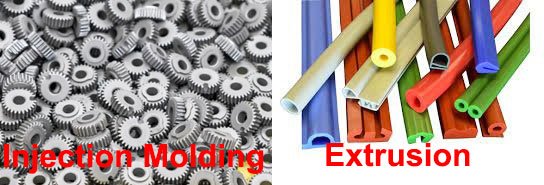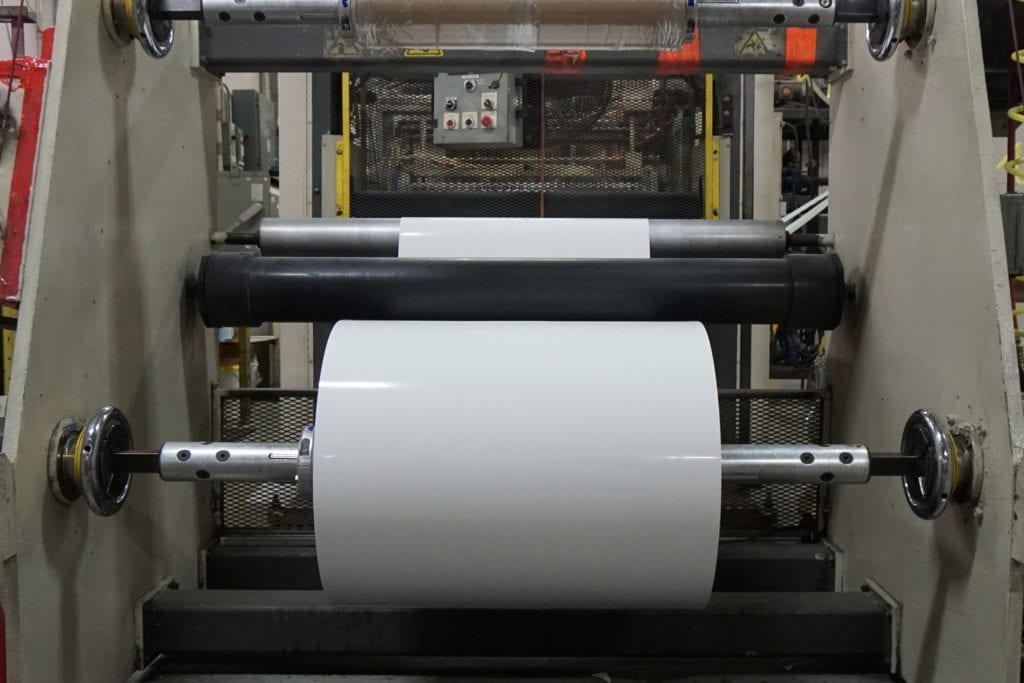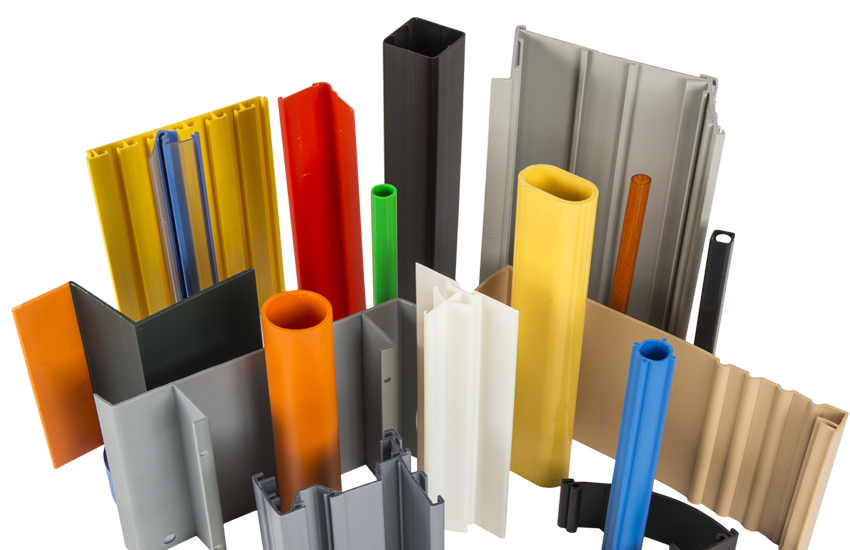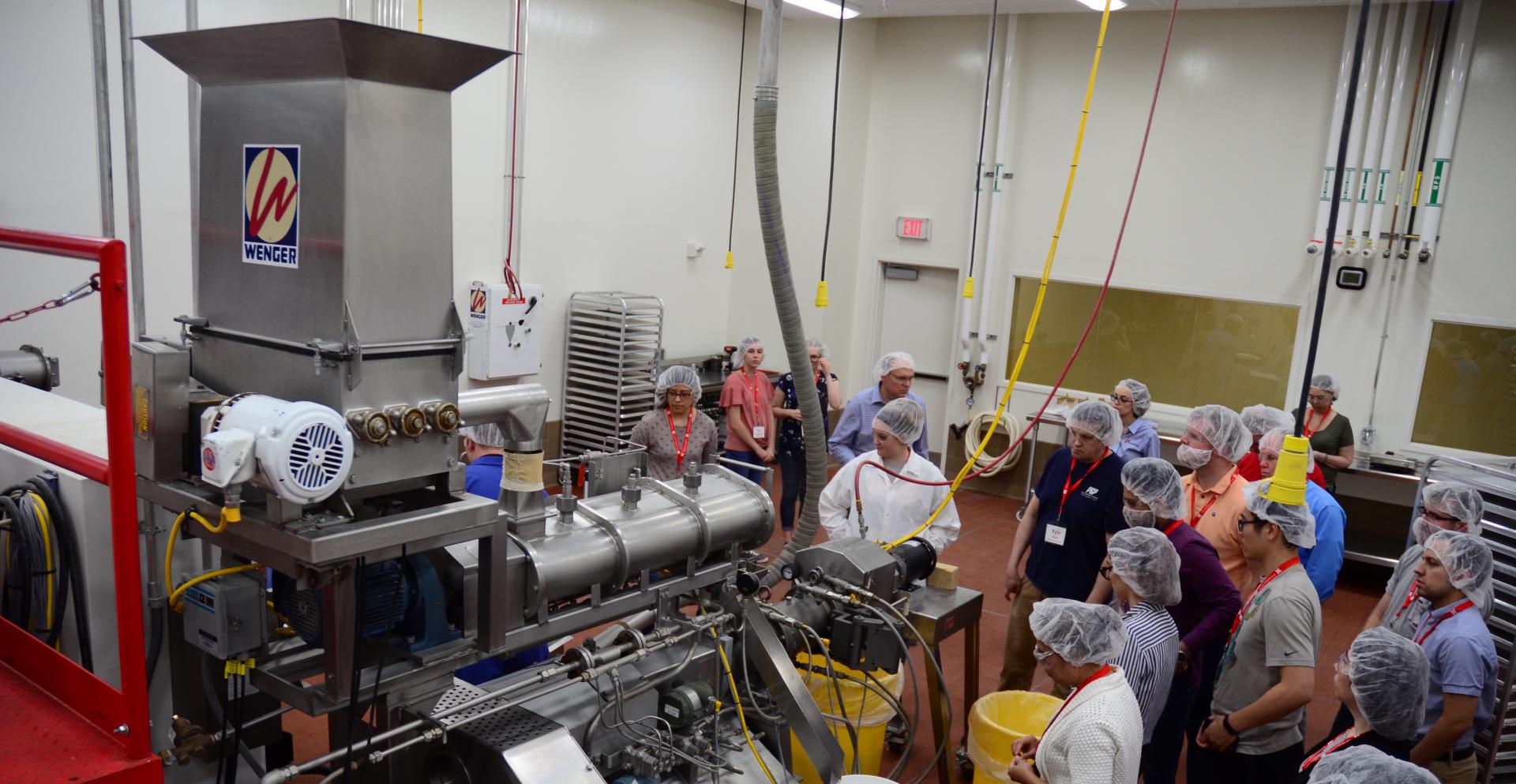Injection molding and extrusion differ mainly in their processes, where injection molding involves injecting molten material into molds, while extrusion pushes material through a shaped die.

Basic Process Descriptions
Injection Molding Process
Injection molding involves melting plastic pellets and injecting the molten plastic into a mold. Once inside the mold, the material cools and solidifies, taking the shape of the cavity. Here’s a breakdown of the process:
- Material Preparation First, select the plastic material and prepare it for molding. This often involves drying it to remove any moisture.
- Melting The plastic pellets move into a heating cylinder, where they melt into a liquid form.
- Injecting A screw or ram then forces the molten plastic into the mold, which is often made from metal, usually either steel or aluminum.
- Cooling and Solidifying The plastic solidifies as it cools, adopting the shape of the mold.
- Ejection Once sufficiently cooled and solid, the newly formed part ejects from the mold, and the process can begin anew.
Extrusion Process
In the extrusion process, manufacturers push or draw material through a die to create long objects of a fixed cross-sectional profile. The procedure varies depending on the material type and desired application but typically follows these general steps:
- Raw Material Feeding Feed the starting material, commonly in pellet or granule form, into the extruder.
- Melting and Conveying Heaters melt the material, and a screw mechanism conveys it along the barrel of the extruder.
- Forming The molten material is forced through a die, acquiring its shape as it does so.
- Cooling The extruded material cools, often through contact with air or water.
- Cutting or Spooling After cooling, cut the extrudate to length or wind it onto spools for further use in other manufacturing processes.
Material Usage
Types of Materials Used in Injection Molding
Injection molding utilizes various materials, primarily thermoplastics, due to their ability to be melted and re-melted without significant degradation. Some commonly used materials include:
Polyethylene (PE)
-
- Noted for its ease of processing and low cost, with a typical price of around $1 to $1.50 per pound.
- Offers resistance to moisture and chemicals.
Polypropylene (PP)
-
- Often chosen for its balance between cost (approximately $0.50 to $1.50 per pound) and performance.
- Resistant to chemicals and possesses elasticity and toughness.
Polyvinyl Chloride (PVC)
-
- Widely used due to its flame retardancy and excellent electrical insulation properties.
- Its cost usually falls in the range of $0.50 to $1.50 per pound.
Polyethylene Terephthalate (PET)
-
- Known for its clarity and is commonly used in packaging applications.
- Prices can vary based on grade and supplier, typically around $1.20 to $1.50 per pound.
Different projects might demand different types of plastics, depending on requirements such as strength, flexibility, transparency, and resistance to heat and chemicals.
Types of Materials Used in Extrusion
Extrusion also employs a variety of materials, each serving specific purposes:
Polystyrene (PS)
-
- Utilized for its ease of processing and low-cost (around $1 to $2 per pound).
- Commonly found in disposable cutlery and CD cases.
Polyethylene
-
- Widely used due to its flexibility and durability.
- Ideal for producing films, bags, and sheeting.
Polypropylene
-
- Chosen for applications requiring high stiffness and heat resistance.
- Applied in the production of BOPP films.
Polyvinyl Chloride (PVC)
-
- Noted for its versatility in extruded profiles, such as window frames and pipes.
- Its price fluctuates, but it’s considered a cost-effective material for pipes and fittings.

Application Areas
Common Products Manufactured through Injection Molding
Injection molding’s precision, consistency, and material versatility make it popular across numerous industries:
Automotive
-
- Produces complex and durable components, like dashboards and bumpers.
Medical Devices
-
- Facilitates the creation of intricate and clean components like syringes and dental implants, where a material like Polypropylene may be utilized due to its resistance to chemical attack by sterilizing agents.
Consumer Electronics
-
- Employs materials like Polycarbonate/Acrylonitrile Butadiene Styrene (PC/ABS) blends for their balance of strength and aesthetic properties in making items like cell phone and computer parts.
Common Products Manufactured through Extrusion
Extrusion is vital in creating linear products and is indispensable in various sectors:
Construction Industry
-
- Produces PVC pipes due to PVC’s chemical resistance, affordability (keeping the budget around $2 to $5 per foot for smaller diameter pipes), and ease of connection.
Packaging
-
- Creates thin films and sheets for packaging goods, frequently utilizing Low-Density Polyethylene (LDPE) due to its excellent film-forming properties.
Furniture
-
- Produces profiles for window frames and furniture components.
Machinery and Equipment
Equipment Used in Injection Molding
Injection molding machines form the core of the injection molding process. These machines have three primary components:
Injection Unit
-
- Melts the plastic and injects it into the mold. Commonly, injection units must endure high-pressure, which varies between 10,000 psi to over 30,000 psi due to the viscosity of certain plastics.
- They also contain the hopper, where plastic pellets are fed into the machine, and usually, screws, which help in mixing and injecting the plastic.
Clamping Unit
-
- Holds and closes the molds under pressure during the injection and cooling process. The clamp force should be sufficiently high, as insufficient force will cause the molten plastic to leak, adversely affecting the quality of the product.
- The clamping unit also enables the mold to open and close, providing access for the removal of finished parts.
Control Unit
-
- Manages the various functions and ensures consistency in the production process. Modern control units leverage advanced software to optimize conditions such as temperature, cycle time, and pressure.
These machines can vary in size and capacity, with smaller units producing very small parts at high speeds, while larger machines can produce larger parts, like car bumpers, at slower speeds.
Equipment Used in Extrusion
Extrusion machinery is crucial in enabling the continuous manufacturing of products like tubes, films, and profiles. Key components include:
Extruder
-
- The heart of the system, where the material melts and gets conveyed towards the die. The extruder contains a large screw that pushes the plastic through a heated barrel, melting it in preparation for extrusion.
- The barrel temperature, screw speed, and design are critical parameters that influence the properties and quality of the final product.
Die
-
- A custom-designed tool that shapes the molten plastic into the desired profile. The complexity and precision of the die directly affect both the quality of the finished product and the production speed, impacting throughput and cost.
- Dies must be expertly designed and manufactured to ensure they provide the required shape while also allowing for consistent flow of the molten material.
Cooling System
-
- Facilitates the solidification of the extruded plastic, typically using air or water cooling systems. The efficiency of the cooling system is crucial to maintaining high production speeds and product quality.
Cutter or Spool
-
- Depending on the product, the extrudate may be cut into predetermined lengths or wound onto spools for further manufacturing processes.

Advantages and Disadvantages
Advantages of Injection Molding
Injection molding is a widely used manufacturing method, providing numerous benefits such as:
High Production Speeds
-
- Injection molding machines can produce astonishingly high quantities of parts rapidly, making it an ideal process for mass production.
Precision and Consistency
Once the molds are created, they can produce large numbers of identical parts with very tight tolerances, providing incredible detail and consistency.
- Complex Part Manufacturing
- Injection molding can handle complex parts that would be otherwise difficult or costly to manufacture through other methods.
- Automation Possibility
- A lot of the injection molding process can be automated, which can significantly reduce labor costs and also ensure higher precision during production.
Advantages of Extrusion
Extrusion also brings forth several distinct advantages in the manufacturing world, including:
Versatility in Shape
-
- The process can create a wide array of cross-sectional profiles, granting immense flexibility in product design.
Efficient Mass Production
-
- The continuous nature of extrusion allows for high-efficiency mass production of linear products.
Material Efficiency
-
- Extrusion generally offers high material efficiency, minimizing waste and making it possible to utilize a high percentage of the raw material in the final product.
Co-Extrusion Possibility
-
- The extrusion process allows for co-extrusion, where different materials or colors can be combined in a single profile, enhancing product functionality and aesthetics.
Disadvantages of Injection Molding
Despite its many advantages, injection molding comes with certain drawbacks:
High Initial Costs
-
- The initial investment for creating molds can be significantly high, especially for high-quality, precision molds.
Limitations on Part Size
-
- There are restrictions on the maximum size of parts that can be effectively injection molded, which is determined by the capacity of the injection molding machine.
Material Limitations
-
- Some materials cannot withstand the high pressures of injection molding or may be too abrasive for the molds, limiting material options.
Complex Setup
-
- Setting up an injection molding process requires expertise and can be time-consuming to establish optimal conditions.
Disadvantages of Extrusion
Extrusion, while valuable, is not without its limitations:
- Limited to Constant Cross-Sectional Profiles
- The process is restricted to producing parts with constant cross-sectional profiles, limiting design flexibility.
- Start-Up Costs
- The dies used in extrusion, especially more complex ones, can be expensive to design and manufacture.
- Material Consistency Required
- Materials need to be consistent in their melt flow characteristics to avoid imperfections in the final product.
- Difficulty with Certain Materials
- Some materials may not lend themselves well to the extrusion process due to their melting characteristics or strength properties.
Cost Implications
Cost Factors in Injection Molding
The cost implications of injection molding are influenced by various factors which significantly impact the budget and economic viability of a project:
- Mold Costs
- The creation of molds can be notably expensive, especially for detailed or large parts. High precision molds made from durable metals can cost anywhere from a few thousand to several tens of thousands of dollars.
- Material Costs
- Different thermoplastics come at different price points, and the choice of material impacts the overall cost. For instance, specialty materials with higher heat resistance or strength are typically more expensive than standard plastics.
- Production Volume
- The production volume is crucial in determining the cost-per-unit. Injection molding may not be cost-effective for low volumes due to the high initial mold costs.
- Labor Costs
- Although injection molding can be largely automated, operational labor costs, maintenance, and any required manual assembly or post-processing will also influence costs.
- Energy Costs
- The operation of injection molding machines, especially larger ones, can consume a significant amount of energy, contributing to operational costs.
- Quality Assurance
- The implementation of quality assurance processes, like inspection and testing, incurs additional costs but is essential to maintain product quality and compliance.
Cost Factors in Extrusion
Various elements contribute to the cost aspects of extrusion, each playing a role in shaping the financial considerations of a manufacturing project:
- Die Costs
- Like molds in injection molding, dies in extrusion can be expensive to design and manufacture, particularly those with intricate or specialized profiles.
- Material Costs
- The type of material used influences not only the product characteristics but also the overall costs. Specialty polymers or those with specific additives will generally be pricier.
- Setup Costs
- The setup of extrusion processes, including die swapping and calibration of parameters, can be labor-intensive, impacting costs, especially for shorter runs.
- Production Speed
- The speed of production in extrusion affects the throughput and can be a vital factor in determining the overall cost-effectiveness and efficiency of a project.
- Energy Consumption
- Extruders, especially larger ones, can be significant consumers of electricity, adding to the operational expenses.
- Post-Extrusion Processes
- Additional processes like cutting, bending, or any further assembly will introduce additional labor and operational costs.
- Quality Control
- Ensuring consistent quality in extrusion requires monitoring and quality control measures, which also carry associated costs.
Quality and Tolerance
Quality Considerations in Injection Molding
Ensuring quality in injection molding involves overseeing several aspects:
- Material Quality
- Using high-grade materials is fundamental to obtaining high-quality final products. Ensuring materials are free from impurities and have consistent properties is essential.
- Mold Precision
- The accuracy and precision of the mold will directly influence the quality of the produced parts. Precision machining and maintenance of the molds are crucial.
- Process Control
- Maintaining consistent process parameters like temperature, pressure, and cycle time is vital to ensure each part is formed under identical conditions, maintaining quality across the production.
- Post-Molding Handling
- How parts are handled, stored, and transported after molding also influences their final quality, especially regarding potential for warpage or surface damage.
Quality Considerations in Extrusion
Quality in extrusion can be affected by various factors:
- Die Design and Quality
- Proper design and high-quality manufacturing of the die are paramount to ensuring the extruded profiles meet design specifications.
- Material Consistency
- Ensuring the material is consistent in its properties and free from contaminants is crucial to prevent defects in the extruded product.
- Process Stability
- Stable and well-controlled extrusion processes ensure consistent dimensions and properties along the entire length of the extruded profile.
- Cooling Consistency
- Uniform and gradual cooling is essential to prevent warpage and internal stresses in the extruded product.

Tolerance Levels in Injection Molding
Tolerances in injection molding refer to the allowable deviation from the specified dimensions and are vital for ensuring parts fit and function correctly.
- Material and Process Impact
- Different materials and process parameters can impact achievable tolerances. Some high-precision materials and optimized processes can achieve tolerances as tight as ±0.001 inches.
- Mold Accuracy
- The precision of the mold is fundamental to achieving tight tolerances and must be factored into both the design and manufacturing processes.
- Part Geometry
- More complex parts or those with thin walls may be subject to greater variability in tolerances and may require specialized design considerations.
- Post-Molding Shrinkage
- Allowing for the shrinkage of materials as they cool is essential to maintaining tight tolerances in the final part.
Tolerance Levels in Extrusion
In extrusion, tolerances can also play a pivotal role in the functionality and quality of the final product:
Die Precision
-
- The accuracy of the die directly impacts the tolerances of the extruded profile and must be considered in die design and manufacturing.
Material Behavior
-
- Understanding how the material behaves during extrusion and cooling is vital for maintaining tolerances, as different materials may exhibit varying degrees of shrinkage or deformation.
Process Stability
-
- Maintaining a stable extrusion process ensures consistent flow and cooling, contributing to maintaining tolerances across the length of the extrusion.
Cooling Uniformity
-
- Ensuring the extruded profile cools uniformly and at the correct rate is crucial to maintaining the dimensional stability and tolerances of the final product.





